The Jeepney "Ang Sasakyang Pangmasa (The Vehicle for the Masses)
The Jeepney "Ang Sasakyang Pangmasa (The Vehicle for the Masses)
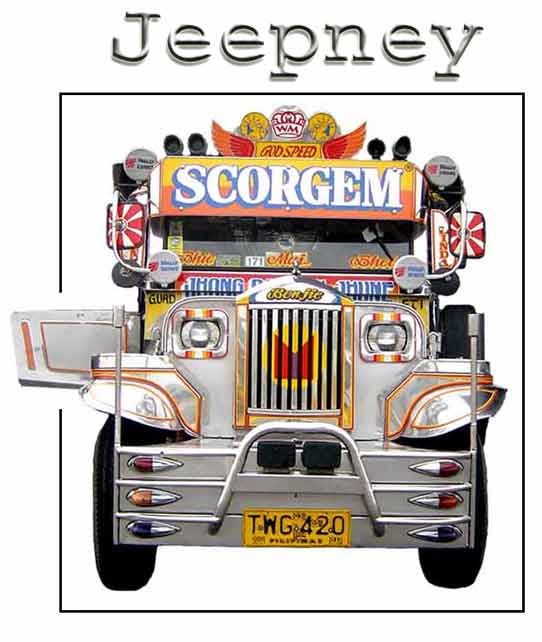
The Jeepney was once called the "Undisputed King of the Road". . . . . . but no longer. Indeed, once it was the symbol of Filipino creativity, innovativeness and ingenuity. Today, it is a tarnished icon, its survival threatented from many fronts – bullied by government regulations, victimized by rising costs and the competition of cheaper alternatives. Surely, it has come a long way from being the World War ll Willysjeep surplus that provided an early postwar topless form of share-taxi transportation, soon enough acquiring a roof and stretching the back to accommodate more passengers, taking on colors and accessories. Even as the supply of Willy jeeps and alternative mother-vehicles became exhausted, it continued to spawn an industry and commerce of build-from-scratch jeepney production, providing the needs of the populace for an affordable means of transportation and all imaginable hauling needs. It was, indeed, the workhorse of Philippine transportation, and deservedly for decades, it was the "Undisputed King of the Road."
To say that it continues to be the symbol of the Filipino's creativity, innovativeness and ingenuity is arguable. The jeepney has remained in its angular and boxy construction, gas-guzzling and weighty with its
In an age of incredible automotive innovations for fuel efficiency, aerodynamics, safety and creature comforts, the jeepney has remained an immutable, uncomfortable, gas-guzzling and polluting anachronism, severely lacking in safety features and unadaptable to universal safety and seat-belt regulations. Its boxed interior is designed to cram up as many passengers as possible. Check out the spare tire, easily inspected on the driver-side, and the threads are usually so worn out, dental floss in the groove would stick out. Some are a thumb-tack away from a blown-tire. It's the nature of this beast–surplus and recycled parts,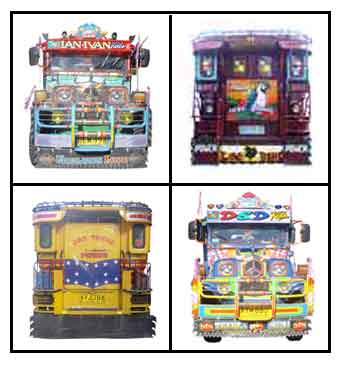 20 plus sheets of 15- to 18-gauge stainless steel or galvanized sheets, its guts usually surplus Japanese diesel engines and chassis, its aerodynamics eaten up by an unyielding metal shell and its profusion of accessories, mirrors, grills and guards. 20 plus sheets of 15- to 18-gauge stainless steel or galvanized sheets, its guts usually surplus Japanese diesel engines and chassis, its aerodynamics eaten up by an unyielding metal shell and its profusion of accessories, mirrors, grills and guards.Ubiquitous in the pages of travel brochures, the jeepney is often blazoned as an "essential part of the Philippine adventure" . . . Uhmm. . . well, sort of. . . in a Third-World-cheap-thrills kind of way. A Can of Sardines It is devoid of passenger comforts. Depending on length, it can load from 18 to 30 passengers, the drivers usually waiting for a full load before going his way. And on a full load, it's a can of sardines, 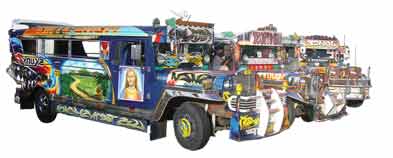 shoulder-unto-armpit, back-unto-chest, shoulder-unto-shoulder, elbow-unto-hipbone, unavoidable thigh-on-thigh intimacy, butts accommodating forward to the seat's edge as another squooshes back to mold into tight spaces. It's a disparate mix of the 'masa' forced into sharing a humid olfactory and respiratory environ teeming with the composite scents of body odors, fading perfumery, and the more than occasional passenger reeking of alcohol, his head drifting into a slumberous rest on a fellow passenger's shoulder. The open windows welcome the miasma of urban ground ozone pollution and freshly brewed and belched smoky black clouds of diesel fumes spewed out by buses and jeepneys alike. For the masa, it is a daily sufferance in a cramped space that tests the limits of jeepney etiquette. And for some men, "chancing" and voyeur opportunities, eyeballs rolling and roving for beaver shots and cleavage gazing, while women desperately cover their necklines and tug down their hemlines. shoulder-unto-armpit, back-unto-chest, shoulder-unto-shoulder, elbow-unto-hipbone, unavoidable thigh-on-thigh intimacy, butts accommodating forward to the seat's edge as another squooshes back to mold into tight spaces. It's a disparate mix of the 'masa' forced into sharing a humid olfactory and respiratory environ teeming with the composite scents of body odors, fading perfumery, and the more than occasional passenger reeking of alcohol, his head drifting into a slumberous rest on a fellow passenger's shoulder. The open windows welcome the miasma of urban ground ozone pollution and freshly brewed and belched smoky black clouds of diesel fumes spewed out by buses and jeepneys alike. For the masa, it is a daily sufferance in a cramped space that tests the limits of jeepney etiquette. And for some men, "chancing" and voyeur opportunities, eyeballs rolling and roving for beaver shots and cleavage gazing, while women desperately cover their necklines and tug down their hemlines.
 A work of Art on Wheels?Alas, most of the almost quarter of a million jeepneys roaming the urban thoroughfares, provincial roads and rural backroads fail in the category of Filipino jeepney creativity, drab in their galvanized shells with a modicum of streaks or strips of color and minimum of accessories. Some are barely functional geriatric metalworks on wheels, plying their routes to eke out a daily survival. And for the riding public, the masa, long jaded from its ubiquity and blind to the 'art', the jeepney is nothing but that utilitarian mode of transportation – available and affordable. 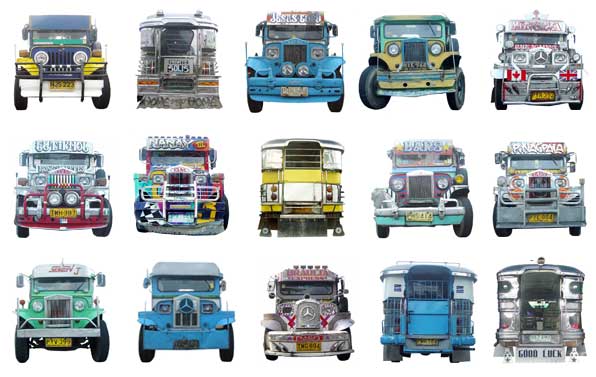 But there head-turners, jeepneys that qualify as "art-on-wheels," although few and far in-between — show-case jeepneys made especially for tours, fairs and exhibits and privately owned jeepneys — malignant with art and accessories, veritable works of art, glistening in their shining armor of steel, their hoods crowded with protrusions of accessories, its sides an expanse of metal canvas colorfully filled with sticker or airbrushed art. Of these few, most are owned by those with deep pockets; a few, perhaps, who have found in their rolling canvas of steel an outlet for their creative expression; and some, by those who save or readily put out their last pesos to upgrade or add a borloloy here and there. . . .taking pride, or doing it . . . just because.  THE ART 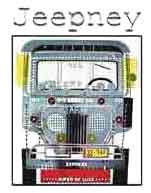 Jeepney art is a combination of the "art of the accessory" and the "art of the color" applied on a basic canvas shell of galvanized metal or buffed and glimmering stainless steel. Accessories are, for the most part, decided or handpicked, altered or added on at the owner's whim. The "art of the color" is usually applied by airbrush or sticker artists. Many jeepneys concentrate the art on the front, insanely cramming the hood area with accessories, the sides with empty galvanized expanses or scatterings of ads and small art. Some are gleamingly and colorfully wrapped with accessories and airbrushed or stickered art. Jeepney art is a combination of the "art of the accessory" and the "art of the color" applied on a basic canvas shell of galvanized metal or buffed and glimmering stainless steel. Accessories are, for the most part, decided or handpicked, altered or added on at the owner's whim. The "art of the color" is usually applied by airbrush or sticker artists. Many jeepneys concentrate the art on the front, insanely cramming the hood area with accessories, the sides with empty galvanized expanses or scatterings of ads and small art. Some are gleamingly and colorfully wrapped with accessories and airbrushed or stickered art.No two jeepneys are alike. Even the drab generics show distinct differences. Customization starts with the shell, a detail here and a detail there. Then the myriad of personal touches - a choice accessory, horses and horns, lights and mirrors, flaps and guards, names and dedications, a color preference, an art theme, a religious icon or invocation - a composite of details that proudly blazons a signature, a personal statement and ownership. 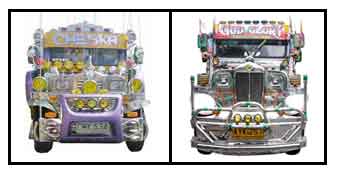 The art of the borloloysAccessories are often more defining to jeepney design than color. Usually symmetric and for the most part concentrated and insanely crammed on the front-hood area, they number from a few to many to excessive to pathologic-excessive: A composite of guide bars, racks and rails, grille-works, chromed horses and horns, a profusion of mirrors and lights and antennae functional and faux. Then, there are the panel boards and the crowns, the decorative mud flaps and splash guards, fenders and bull bars, and of course, the finishing touch on the center-grille, emblazoned with conspicuous and over-sized automotive emblems, most often, the "Mercedes Benz." The art of the borloloysAccessories are often more defining to jeepney design than color. Usually symmetric and for the most part concentrated and insanely crammed on the front-hood area, they number from a few to many to excessive to pathologic-excessive: A composite of guide bars, racks and rails, grille-works, chromed horses and horns, a profusion of mirrors and lights and antennae functional and faux. Then, there are the panel boards and the crowns, the decorative mud flaps and splash guards, fenders and bull bars, and of course, the finishing touch on the center-grille, emblazoned with conspicuous and over-sized automotive emblems, most often, the "Mercedes Benz."
The art of the color
It is a rare jeepney that does not use color - that rare specimen of pure gleaming stainless steel nakedness or dreadfully barren galvanized shell. Color dresses up the metal shell. The front, usually so crammed and crowded with accessories, take on simple accenting and decorating stripes of color on the hoods and fenders. Some jeepneys cram the all the accessories and art in front, leaving the side bare and barren, typical of many jeepneys plying the San Pablo-Tiaong-Candelaria route. For many jeepneys, the "visual art" extends to the sides, long expanses of metal for more proletarian doodling of sticker-art collage. And sometimes, the art and the color extends all the way to the back. (See: Jeepney 88 and Jeepney 87) 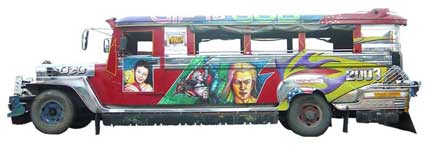 The art is usually the handiwork of jeepney artists. Although there are set-designs, the prospective owners may request certain themes or the addition of The art is usually the handiwork of jeepney artists. Although there are set-designs, the prospective owners may request certain themes or the addition of  religious images or favorite quotes that are easily accommodated into the vast canvas of its metal shell. Most of the art is done through the use of colored plastic stickers, available in 6" wide rolls, costing P35 per foot, an average jeepney using between 150 to 220 feet, painstakingly and economically cut into design and seamlessly applied to the outside metal work, the labor cost ranging from P2,500 to P3,500. With the limitations of sticker art and colors, some prefer the use of airbrush painting allowing an expanded thematic spectrum – 'heavy metal' and fantasy-type art –and tonal values unachievable with sticker art . Not uncommonly, the side-art accommodates an incongruity of themes, an image of Christ juxtaposed with fighter planes, religious icons jostling for space with heavy metal images, a Disney character or NBA team logo or a sundry of things American for any leftover space big enough to accommodate it. religious images or favorite quotes that are easily accommodated into the vast canvas of its metal shell. Most of the art is done through the use of colored plastic stickers, available in 6" wide rolls, costing P35 per foot, an average jeepney using between 150 to 220 feet, painstakingly and economically cut into design and seamlessly applied to the outside metal work, the labor cost ranging from P2,500 to P3,500. With the limitations of sticker art and colors, some prefer the use of airbrush painting allowing an expanded thematic spectrum – 'heavy metal' and fantasy-type art –and tonal values unachievable with sticker art . Not uncommonly, the side-art accommodates an incongruity of themes, an image of Christ juxtaposed with fighter planes, religious icons jostling for space with heavy metal images, a Disney character or NBA team logo or a sundry of things American for any leftover space big enough to accommodate it.And they are out there, alas, buried in ubiquity. But seek and you shall find – rare pieces of metalworks, strutting design and screaming attitude. They deserve a smile, a nod, or a thumbs-up. 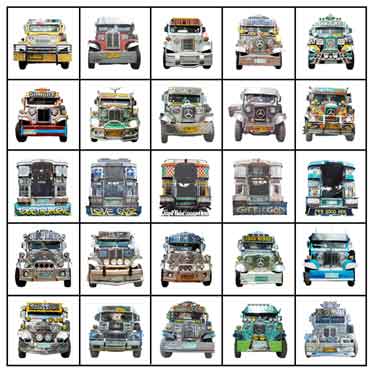 It is art. . . Rococo. Baroque. Pop. Dada. Mobile art. Construction art. Collage-on-wheels. Art-on-wheels. Graffiti-on-wheels. Folk art. Pinoy art. People's art. Proletarian Art. Masa Art.In a country devoid of any populist program of art, where art is an indulgence of the literati and bourgeoisie, jeepney art is probably the sole venue for expression of true proletarian art. It is art. . . Rococo. Baroque. Pop. Dada. Mobile art. Construction art. Collage-on-wheels. Art-on-wheels. Graffiti-on-wheels. Folk art. Pinoy art. People's art. Proletarian Art. Masa Art.In a country devoid of any populist program of art, where art is an indulgence of the literati and bourgeoisie, jeepney art is probably the sole venue for expression of true proletarian art.
Styles and sizes.
Altars and angels. Ads on wheels.
Styles vary regionally. The use of "borloloys" (accessories) are typical in the urban-suburban areas and most provinces. There are cycles and regional preferences for certain accessories, colors and sticker art. In some regions , horses and mirrors might dominate the hoodspace; in others, lights and antennae. Jeepney-gazers can spot and identify details of color, art and style and say: That's a mid-80s Amante! . . or. . . That's an Armac!
The jeepneys in the Biñan-Calamba area are stylistically spartan with a minimum of sticker art and accessories, and a distinctly different roof style constructed with padded canvas, The Baguio jeepneys sit higher up off the ground, almost all with roof -racks for top-load hauling and the spare-tire, weather-proofed with double back doors and sliding windows, and an outside art showing showing an affinity for American places and icons, cowboys and indians, NBA logos, and their signaturewide-stripes of colors.The inside has not changed much in the past decades — relatively barren compared to the frenzy of colors and accessories on the outside. The back's length dimension may be custom-stretched to accommodate as much as 28 passengers, 14 abreast. On average, passenger jeepneys sit 16 to 20 in the back, on padded bench-type seats; 2 passengers in front, plus the driver. There are ceiling hand-rails to hold on to. Roll-down window shades for rainy days or a touch of frau-frau with frilly crocheted sliding curtains. Billboard on Wheels Often, the insane collage of images will include images of commercial products, logos on wheelcovers and fender doodads – getting a free ride on advertisements. Jeepneys are also contracted for short-term rooftop ads or the whole jeepney dedicated to a single product, as in the Motorola and Coca-cola jeepneys. Election years bring a market for political campaign rolling ads on-the-cheap.  King of the road. . . not. The decline? Alas, the past decade has seen a slow decline in the jeepney's dominant status as the "King of the Road." To relieve traffic congestion, jeepneys were bullied and selectively banned from some of the main thoroughfares. Government franchise regulations, the Asian financial crises and the skyrocketing costs for Japanese engines and parts converged together to cause irreparable bleeding and helped sound the death knell for some in the jeepney industry. Sarao and many other big names in jeepney production have succumbed. 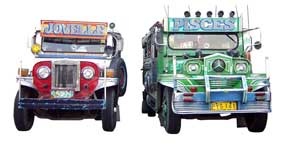  Short routes and small-load needs have been supplanted by the pesky tricycle (Trik), nimble and superior it its maneuverability, able to U-turn on a dime. Perhaps, as some observers have posited, Trik can claim the title of the new "King of the Road." Many say: King Pest of the Road. Short routes and small-load needs have been supplanted by the pesky tricycle (Trik), nimble and superior it its maneuverability, able to U-turn on a dime. Perhaps, as some observers have posited, Trik can claim the title of the new "King of the Road." Many say: King Pest of the Road.The "Family Jeepney" has been largely replaced by surplus vans from Japan, more economical in gas consumption, air-conditioned to boot, a step-up in the ladder of consumer status. Hauling alternatives are now provided by medium-sized Elfs and bigger for-hire vehicles. In the urban settings, its share of passengers has been decimated by affordable air-conditioned share-taxis or vans. Many feel the jeepney has been bullied by edicts banning them from major passenger routes, Add to that: government imposed rates, licensing, the rising cost of fuel prices and maintenance, and the increasing difficulty in meeting and existing on the "boundary" arrangements between jeepney owner and contracted driver, the latter taking home a third of the collected fare. In some provinces, it thrives. In Baguio, where there is a ban on tricycles, the jeepneys continue to reign supreme.
•
|
 |
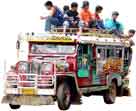
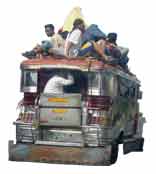
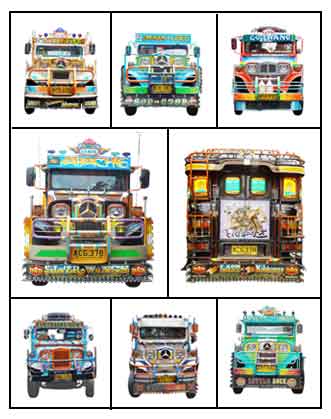
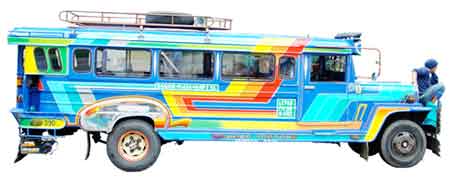

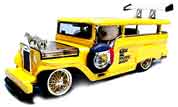
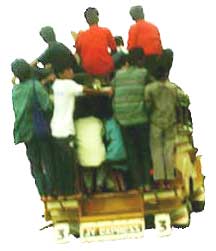
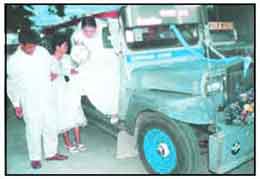

0 Mga Komento:
Mag-post ng isang Komento
Mag-subscribe sa I-post ang Mga Komento [Atom]
<< Home